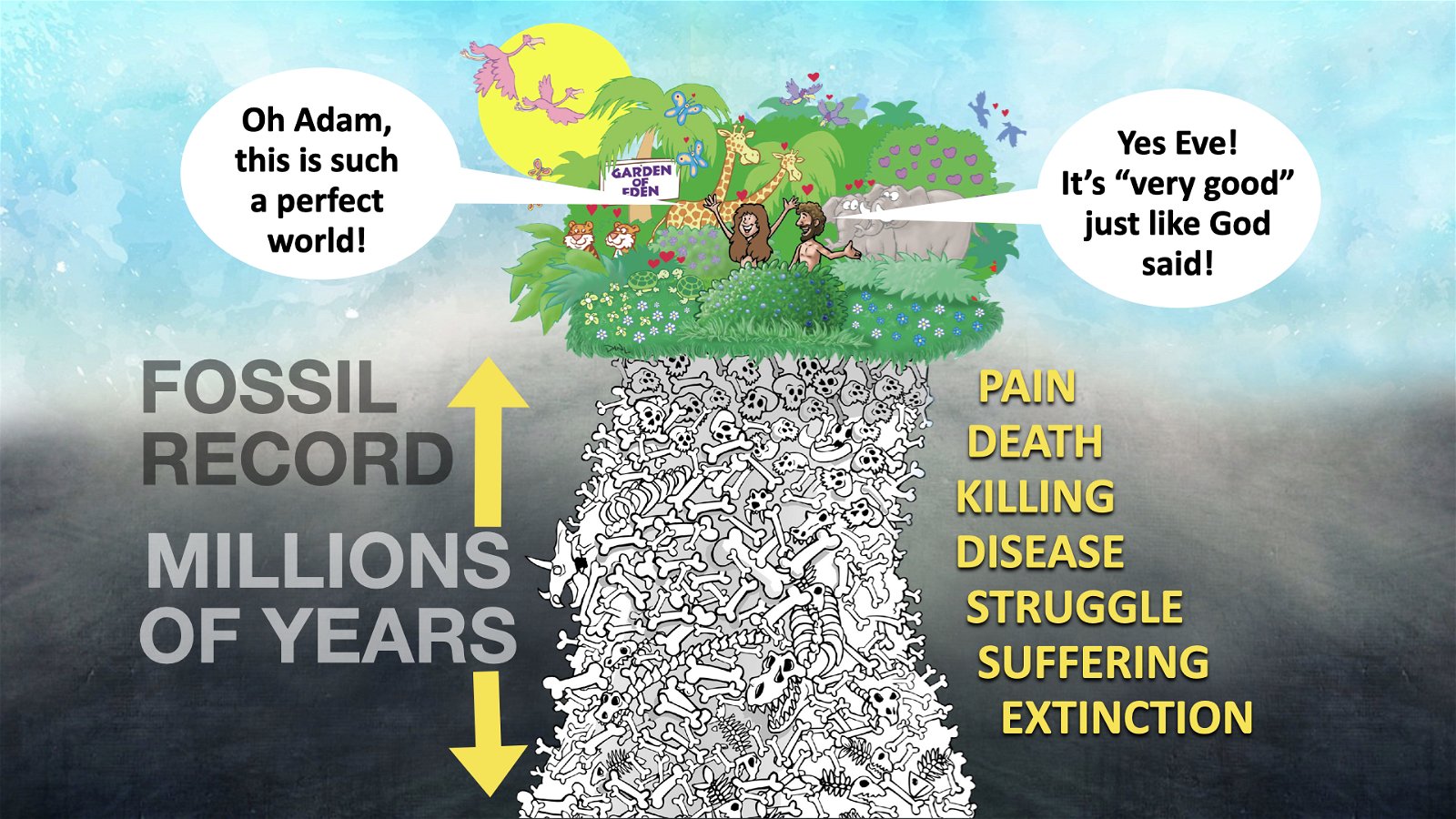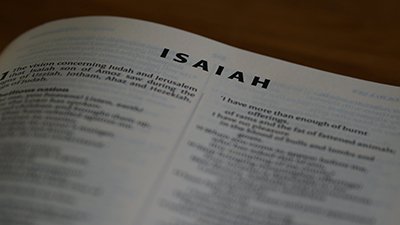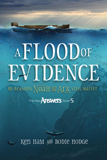Noah’s Flood: a Historical, Global Catastrophe
Examining the immense biblical data for Noah’s flood as an actual, year-long, worldwide, and catastrophic flood about 4,500 years ago
I have had the privilege of speaking on creation and evolution in 35 countries, and I have found that most Christians have never considered the biblical and scientific evidence that Genesis 1–11 is literal history and teaches that the creation is only about 6000 years old. I have also found that most Christians accept the claim made by the scientific majority that the earth is billions of years old. I have further found that whether Christians accept the millions of years or not, the vast majority have never considered Noah’s flood and its relevance to the question of the age of the earth.
But Noah’s flood is critical to that question. Simply put, if that flood was a global, year-long, catastrophic event about 4,500 years ago, as Genesis appears to teach, then it is very reasonable to conclude that it would have produced an incredible amount of erosion and sedimentation and would have buried many plants and animals in those sediments, which would later become fossils as the sediments hardened into rock. Creation geologists believe the flood would have produced exactly the kind of geological features that we see all over the earth, as, for example, are beautifully displayed in the walls of the Grand Canyon in Arizona, USA. These Bible-believing geologists think that most (not all) of the fossil-bearing sedimentary rock layers are the result of the flood. But secular geologists, who reject God’s eyewitness testimony in Genesis 6–9, say those rock layers were formed over hundreds of millions of years. So, if the flood produced most of the fossiliferous sedimentary layers around the world, then those layers cannot be the result of hundreds of millions of years of erosion and sedimentation, as the secularists claim.
For the first 1,800 years, the virtually universal belief in the church was that Noah’s flood was a historical, year-long, global catastrophe. But in the early 19th century, the idea of millions of years became entrenched in the infant science of geology.
For the first 1,800 years, the virtually universal belief in the church was that Noah’s flood was a historical, year-long, global catastrophe. But in the early 19th century, the idea of millions of years became entrenched in the infant science of geology. Most of the church quickly accepted that idea, so by about 1850, most Christians abandoned that belief about the flood.1 Today, most Christians, including most professing Christian geologists, believe that Noah’s flood was either a myth (i.e., it never happened) or a large but localized flood in the Mesopotamian Valley of the Tigris and Euphrates Rivers (modern-day Iraq) described in exaggerated language.
In this article, I briefly present the biblical evidence that Noah’s flood was a global, catastrophic flood capable of producing most of the geological evidence that most geologists assign to hundreds of millions of years of gradual change.2 The geological reasons for believing in this global flood and a young earth are presented elsewhere.3

Noah’s Flood Really Happened in History.
There are many biblical and extrabiblical lines of evidence that Noah’s flood was a historical event that really happened.
Jesus (Matthew 24:37–39), Peter (1 Peter 3:20, 2 Peter 2:5; 3:3–7), Isaiah (Isaiah 54:9), and Ezekiel (Ezekiel 14:14) believed it was a historical event.
- Eleven times in Genesis, the Hebrew word toledoth appears and is variously translated as “this is the account of” or “these are the generations of.”4 The use of the word ties the whole book together as a historical document, covering the key events of history from creation to the time of Moses.
- The flood account reads like a diary, describing things that happened on specific days in the 600th and 601st years of Noah’s life.
- Jesus (Matthew 24:37–39), Peter (1 Peter 3:20, 2 Peter 2:5; 3:3–7), Isaiah (Isaiah 54:9), and Ezekiel (Ezekiel 14:14) believed it was a historical event. In Isaiah and Ezekiel, God himself is speaking and refers to Noah as a basis for his promises to Israel through these two prophets.
- The genealogy of Jesus demands that the flood really happened, since all of his ancestors (including Noah) must have been real historical people (Luke 3:23–38), or else Jesus was descended from a myth.5
- Hundreds of flood stories from people groups around the world (many of which have details matching those in Genesis 6–9) point to a real historical event in the memory of humanity.6

Noah’s Flood Was Global.
The flood was not localized in the Mesopotamian valley, as many Christians believe, but was global in extent. When the waters reached the highest, there was no land above sea level anywhere on the planet.
Only a global flood would cover all the high mountains under the heavens by at least 15 cubits (about 25 feet or 7 meters: Genesis 7:19).
- Purpose of the Flood. It was sent to destroy not only sinful man but also all land animals and birds not in the ark and the surface of the earth (Genesis 6:7, 13). Birds are mentioned 19 times in Genesis 6–9: the repetition is undoubtedly emphatic and strongly points to the globality of the flood since birds could easily fly out of the flood zone.
- Height of the Flood. Only a global flood would cover all the high mountains under the heavens by at least 15 cubits (about 25 feet or 7 meters: Genesis 7:19). Since water always seeks the lowest level, to cover just the mountains in the Middle East would result in a global flood.
- Duration of the Flood. From the beginning of the flood until the people and animals disembarked on dry ground was 371 days (Genesis 7:11 and 8:14). The reference to 40 days (Genesis 7:12–18) refers to the continuous, torrential rains, but the fountains of the deep did not close and the rains did not stop until the 150th day (Genesis 8:2). It then took another 221 days for the waters to retreat and the land to sufficiently dry out. No local flood could last that long.
- Purpose of the Ark. God told Noah to take onto the ark the birds and land animals that God brought to Noah, so as to repopulate the earth after the flood (Genesis 7:1–3). If the flood would have been localized in the Middle East, the ark would have been totally unnecessary. Even if all the creatures in the local flood zone had died, the area then would have been repopulated by creatures from outside the zone. As for Noah and his family, they could have gone on a vacation to Egypt or Europe. The ark was only and absolutely essential if the flood was global.
- Volume of the Ark. It was unnecessarily large (Genesis 6:15) to save only a few animals, birds, and people from a local flood. But the size described was necessary and adequate to save the number of kinds of creatures taken on board.7
- Landing of the Ark. It landed in the mountains (plural in Hebrew) of Ararat (likely modern-day eastern Turkey), near the top of the highest mountain somewhere in that region at that time. It was 74 days before any nearby mountains could be seen (Genesis 8:4–5). No local flood could raise the ark to this altitude. And only a global flood would require this much time to recede as earth movements uplifted other mountains and the waters retreated into new ocean basins so that other nearby mountains became visible.
- Rainbow Promise. God promised to Noah and his family, to the animals, and the birds on the ark, to all their offspring, and to the earth itself that he would never again send another flood to destroy them (Genesis 9:8–17). If the flood had been local, then God lied because since then there have been many local floods that have killed some animals and people and destroyed large areas of land. But Noah’s flood was global, and God has kept and will keep his promise.
- Post-Flood Command. God directs the animals and Noah’s family to repopulate the earth (Genesis 8:15–17 and 9:1). The commands were only necessary if it were a global flood, since animals and birds outside the flood zone could naturally repopulate the area otherwise.
- Repetition of Universal Terms. The Bible uses such words and phrases as “all,” “every,” “under heaven,” and “in whose nostrils was the breath of life” in the flood account. Certainly, the Hebrew word col (all or every) does not always literally mean all. But it often does. When it does not, the context makes it perfectly clear. In Genesis 6–9, the 60-fold use of these words is emphatically literal.
- The Use of the Hebrew Words “eretz” and “adamah.” The word eretz is used over 2,500 times in the Old Testament. It has multiple meanings: earth (i.e., the planet), ground, land, soil, or country. It also sometimes refers to the people on the earth (e.g., Genesis 11:1). But as with most other words in a Hebrew-English dictionary (and in probably every other language), it is very important to remember that context must always determine the specific meaning in a particular sentence. The word adamah occurs 225 times in the Old Testament and is translated ground or land (either a territory or all the land above sea level). In Genesis 6:1–9:17 (the flood account), eretz is used 48 times, and in no case does the context indicate a geographically limited area. In these chapters, adamah is used nine times. In fact, “face of the ground” in those chapters is a translation of “face of the adamah.”8 “Face of the eretz” is translated as “face of the earth” in most English translations because the context indicates clearly that eretz is referring to all the land on the planet.9
- The Hebrew Word for Flood in Genesis 6–11: mabbul. In these chapters, twelve times God uses the Hebrew word mabbul. It appears only one other time in the Old Testament (Psalm 29:10), where it undoubtedly refers to Noah’s flood since mabbul is preceded in that verse by the definite article (i.e., the flood). It is not referring to any flood, but “the” flood, where God truly showed himself to be the absolute King. All other floods (literal or metaphorical) in the Old Testament are described with the noun, sheteph,10 or the verb, zaram.11 In the New Testament, the Greek word, kataklusmos (from which we get the English “cataclysm”), is used only in reference to Noah’s flood.12 The same is true for the Greek translation of the Old Testament (Septuagint): kataklusmos is only used in Genesis 6–11 and Psalm 29:10 (LXX: Psalm 28:10).
- Jesus and Peter. Both Jesus (Matthew 24:37–39) and Peter (2 Peter 3:3–7) clearly imply the flood was global since they link the judgment of the flood to the future judgment at the second coming of Jesus Christ, which will also have a global effect!
The commands were only necessary if it were a global flood, since animals and birds outside the flood zone could naturally repopulate the area otherwise.

Noah’s Flood Was Catastrophic.
- Purpose of the Flood. Expressing his holy wrath, God intended to “destroy” the surface of the earth (see also 2 Peter 3:6) and “blot out” creatures (Genesis 6:7, 17). This was no peaceful event that would leave no lasting evidence. The language implies a radical transformation of the surface of the earth.
- Source of the Waters. The Hebrew words used in Genesis 7:11 (ESV) are important and revealing. On the first day of the flood, “all the fountains of the great deep burst forth” and “the windows of heaven opened.” The “deep” (tehom) is used 36 times in the Old Testament and usually refers to the oceans. “Fountains” implies subterranean water coming up onto the earth’s surface. “Broke open” is a translation of baqa, which is used in Numbers 16:31 (when God destroyed rebellious Korah and his family and livestock with a small earthquake), in Judges 15:19 (when God broke the rock to provide water for Samson), and in Zechariah 14:4 (where it refers to Jesus splitting the Mount of Olives east of Jerusalem to form a huge valley at his second coming). Genesis 7:12 shows that the “windows of heaven” is a metaphorical way to refer to rain. But this was no spring rain to water the garden. The non-stop global rain for 40 days was an expression of the wrath of God. The language therefore clearly implies earth movements on the deep ocean floor as it broke open (i.e., earthquakes), which would trigger volcanic eruptions, and tsunamis, coupled with torrential global rain, all of which would result in unimaginable destruction.
- Rising of the Waters. The waters did not reach their peak on the first day. That likely did not occur until the 40th day. From the outset when the fountains were broken up, the waters continually rose and prevailed on the land (Genesis 7:18–20). Tsunamis hammered the land, eroding it as the floodwaters surged higher and higher and retreated between surges. So, during the rising of the water, in any given area there would be times of violence and other brief times of relative calm. It would not have been equally catastrophic everywhere at the same time.
- Movement of Waters. Both in the inundation stage and the recessional stage, water would be moving. And moving water erodes sediments and deposits them elsewhere. The Hebrew verbs in Genesis 8:5 clearly indicate a back-and-forth motion, just as the raven flew to and fro (8:7). So, there would have been additional erosion and sedimentation in the recessional stage, reworking material previously deposited during the inundation stage. This was a complex event that would have produced complex geological evidence (just like the evidence we observe in the rocks today).
- Dimensions of the Ark (Genesis 6:15). Scientific research has shown that the ark’s dimensions, particularly its length-width-height ratio, would have provided maximum stability, strength, and comfort to survive the worst sea conditions.13
- Location of the Garden of Eden. The description in Genesis 2:10–14 cannot be harmonized with the geography of the post-Flood Mesopotamian valley or anywhere else on the earth. Genesis says one river flowed out of Eden and divided into four rivers. In Mesopotamia, the Tigris and Euphrates start in two different places in the mountains of Turkey and then join each other just before flowing into the Persian Gulf. The fact that two of the rivers in Genesis 2 have the same names as rivers today is no surprise. As people have migrated on the earth, they have used the same names in the new land that they had in the old country. So, we have Birmingham, England, and Birmingham, Alabama (USA). In New Testament times, Antioch in Syria was not the same city as Antioch in Pisidia. Use of the same names does not necessarily mean we are referring to the same locations. The Garden of Eden cannot be found because the pre-flood world was totally destroyed.
Tsunamis hammered the land, eroding it as the floodwaters surged higher and higher and retreated between surges.

Conclusion
The Bible could not be clearer that the flood was a global catastrophe.
The Bible could not be clearer that the flood was a global catastrophe. Conversely, if the flood were just a big flood in the Middle East, the description in Genesis and other relevant verses could not be more misleading.
Now, what would we expect to find today if this global, year-long, catastrophic flood had occurred? We would expect to find billions of dead plants and animals (both land and sea creatures) buried in various kinds of sediment layers that have hardened into rock and that show evidence of having been deposited in water (not in a desert environment). We would expect to find evidence of massive erosion and sedimentation on a scale unlike anything we observe occurring today. And we would expect to find that same evidence all over the earth. That is exactly what we find! Billions of dead things, buried in rock layers, laid down by water, all over the earth. The question of human fossils is complex and addressed elsewhere.14 But what we see in terms of billions of plant and animal fossils in geographically extensive, water-deposited, sedimentary layers is exactly what we would expect from Noah’s flood.
Now, the Flood is critical to the question of the age of the earth. The thousands of feet of sedimentary rock layers containing billions of dead creatures was formed either before Adam or after Adam. If that geological evidence was formed over millions of years before man appeared on the earth, as evolutionists claim, then God looked at all that death, disease, and extinction and called it “very good” and God’s curse when Adam fell in sin had no impact on the non-human creation (contrary to Genesis 3:14–21, 5:29 and Romans 8:19–23) 15. If that fossil record was formed after Adam sinned, then the most logical cause of most of it was Noah’s flood. So, if we accept the millions of years, then we must reject the global flood as a global catastrophe, which is what most old-earth Christians have done. If we believe God’s Word about the flood, then this is a very important reason for rejecting the millions of years. It is neither logical nor biblical to believe in both Noah’s flood and millions of years of earth history.

If we believe God’s Word about the Flood, we must reject the millions of years.
All the arguments for treating Noah’s flood as a localized event in the Middle East ignore most of the biblical evidence I have presented and give very shallow arguments that do not stand up to scrutiny. The real reason people believe that Noah’s flood was only in the Middle East is that they have uncritically accepted what the majority of geologists say, especially regarding radiometric dating. But I encourage readers to believe God’s clear and inerrant Word rather than the fallible words of sinful people (most of whom are trying to explain the world without God so they do not have to feel corporately or morally accountable to him) and to look at the geological evidence presented in the sources cited in notes 2 and 3.
Let God’s Word be found true and all people who disagree with him found to be liars (Romans 3:4).
Footnotes
- See Terry Mortenson, The Great Turning Point: The Church’s Catastrophic Mistake on Geology—Before Darwin (Green Forest, AR: Master Books, 2004). An illustrated, one-hour summary of that historic rejection of the flood and the biblical chronology is given in my DVD lecture “Millions of Years: Where Did the Idea Come From?”
- For a fuller discussion of the biblical evidence regarding the flood, see Andrew Snelling, Earth’s Catastrophic Past (Dallas, TX: ICR, 2009), I:1–294.
- Most of Snelling’s two-volume, 1,100-page work above explains in layman’s language, but with abundant documentation in the technical scientific literature, the geological evidence confirming the global flood and a young-earth. See also his many geological lectures at https://www.answers.tv/geology-with-dr-snelling or https://answersingenesis.org/media/video/. For teens and adults, a good introduction to the geological evidence, including radiometric dating, is John Morris, The Young Earth (Green Forest, AR: Master Books, 2007).
- Genesis 2:4; 5:1; 6:9; 10:1; 11:10; 11:27; 25:12; 25:19; 36:1; 36:9; 37:2.
- Snelling, Earth’s Catastrophic Past, 99–106.
- Byron C. Nelson, The Deluge Story in Stone (Minneapolis, MN: Bethany Fellowship, 1968; Augsburg, 1931), 165–190. Nelson summarizes 39 of those legends and cites other authors who describe more of them. See also http://www.talkorigins.org/faqs/flood-myths.html.
- Snelling, Earth’s Catastrophic Past, 131–144. Snelling estimated in this 2009 book that fewer than 16,000 animals and birds were on the ark. More recent creationist models about the created kinds indicate there were only about 1,400 kinds and less than 7,000 animals and birds, leaving plenty of room for all the plant material for food.
See the following articles:
- Jean Lightner, “Mammalian Ark Kinds,” Answers Research Journal 5 (October 31, 2012): https://answersingenesis.org/creation-science/baraminology/mammalian-ark-kinds/.
- Tom Hennigan, “An Initial Estimate Toward Identifying and Numbering Amphibian Kinds within the Orders Caudata and Gymnophiona,” Answers Research Journal 6 (January 23, 2013): https://answersingenesis.org/creation-science/baraminology/identifying-and-numbering-amphibian-kinds-results/.
- Tom Hennigan, “An Initial Estimate toward Identifying and Numbering the Frog Kinds on the Ark: Order Anura,” Answers Research Journal 6 (October 2, 2013): https://answersingenesis.org/creation-science/baraminology/an-initial-estimate-toward-identifying-and-numbering-the-frog-kinds-on-the-ark-order-anura/.
- Jean Lightner, “An Initial Estimate of Avian Ark Kinds,” Answers Research Journal 6 (November 27, 2013): https://answersingenesis.org/creation-science/baraminology/an-initial-estimate-of-avian-ark-kinds/.
- Tom Hennigan, “An Initial Estimate toward Identifying and Numbering the Ark Turtle and Crocodile Kinds,” Answers Research Journal 7 (January 8, 2014): https://answersingenesis.org/creation-science/baraminology/an-initial-estimate-toward-identifying-and-numbering-the-ark-turtle-and-crocodile-kinds/.
- Tom Hennigan, “An Initial Estimate toward Identifying and Numbering Extant Tuatara, Amphisbaena, and Snake Kinds,” Answers Research Journal 7 (February 19, 2014): https://answersingenesis.org/creation-science/baraminology/an-initial-estimate-toward-identifying-and-numbering-extant-tuatara-amphisbaena-and-snake-kinds/.
- Marcus Ross, “Fossil Baramins on Noah’s Ark: The ‘Amphibians’,” Answers Research Journal 7 (September 17, 2014): https://answersingenesis.org/creation-science/baraminology/fossil-baramins-noahs-ark-amphibians/.
- Tom Hennigan, “An Initial Estimation of the Numbers and Identification of Extant Non-Snake/Non-Amphisbaenian Lizard Kinds: Order Squamata,” Answers Research Journal 8 (April 8, 2015): https://answersingenesis.org/creation-science/baraminology/initial-estimation-numbers-and-identification-of-order-squamata/.
- Michael Belknap and Tim Chaffey, “How could all the animals fit on the ark?” Answers in Depth 14 (April 2, 2019), https://answersingenesis.org/noahs-ark/how-could-all-animals-fit-ark/.
- The Hebrew word adamah occurs 225 times in the Old Testament and is translated as ground or land. It is used nine times in the flood account. “Face of the ground” (adamah) appears in Genesis 6:1, 6:7, 7:4, 7:23, 8:8, and 8:13 as well as in 2:6. In Genesis 6:20, 7:8, 8:21, and 9:2 adamah appears in phrases like “creeps on the ground” or “curse the ground.”
- “Face of the earth” (eretz), or “face of the whole earth” (col eretz) is used in Genesis 7:3, 8:9, 11:4, 11:8 and 11:9, as well as in 1:29.
- Job 38:25; Psalm 32:6; Proverbs 27:4; Isaiah 54:8; Daniel 9:26; Daniel 11:22; and Nahum 1:8.
- Psalm 77:17 and Psalm 90:5.
- Matthew 24:38–39; Luke 17:27 and 2 Peter 2:5. The associated verb (katakluzomai) is also only used with reference to Noah’s flood (2 Peter 3:6). For other floods, the New Testament uses the noun plēmmura (Luke 6:48) and the noun potamos and adjective potamoforētos (Revelation 12:15).
- Bodie Hodge and Tim Lovett, “What did Noah’s ark look like?” The New Answers Book 3 (Green Forest, AR: Master Books, 2010), https://answersingenesis.org/noahs-ark/what-did-noahs-ark-look-like/ and Tim Lovett, “Could Noah’s ark have been made of wood?” The New Answers Book 4 (Green Forest, AR: Master Books, 2013), https://answersingenesis.org/noahs-ark/noahs-ark-made-of-wood/. Also: Gon et al., “Safety Investigation of Noah’s Ark in a Seaway,” Journal of Creation (formerly Creation Ex Nihilo Technical Journal) 8, no. 1 (1994): 26–36, https://answersingenesis.org/noahs-ark/safety-investigation-of-noahs-ark-in-a-seaway/.
- Snelling 1991 “Where are all the human fossils?” 14, no 1 (December 1991): 28–33, https://answersingenesis.org/fossils/fossil-record/where-are-all-the-human-fossils/ and Troy Lacey and Avery Foley, “Where Are All the Pre-Flood Human Fossils?” August 7, 2018, https://answersingenesis.org/fossils/fossil-record/where-are-all-pre-flood-human-fossils/.
- See Terry Mortenson, “The Fall and the Problem of Millions of Years of Natural Evil,” https://answersingenesis.org/theory-of-evolution/millions-of-years/the-fall-and-the-problem-of-millions-of-years-of-natural-evil/, 18 July 2012..
Recommended Resources

Answers in Genesis is an apologetics ministry, dedicated to helping Christians defend their faith and proclaim the good news of Jesus Christ.
- Customer Service 800.778.3390
- © 2024 Answers in Genesis







